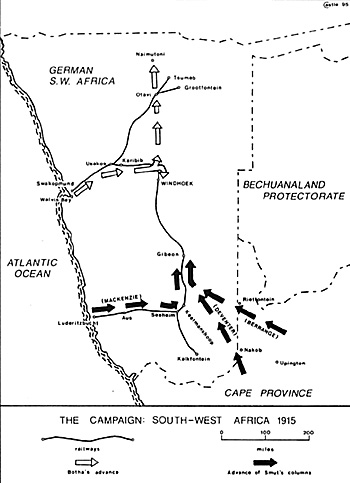 The story of the battle for the German colony of South West
Africa in 1914-15 is a largely forgotten episode of WWI, which even
at the time was neglected in favour of the stirring events in Europe and
other, better-known Colonial episodes, such as the war in East Africa.
Yet this obscure campaign, which pitted thousands of South Africans,
Rhodesians, foreign adventurers of all kinds, and a few British, against a
relative handful of German opponents, and even more formidable
climatic conditions, is worthy of study, as well as possessing interesting
wargaming potential.
The story of the battle for the German colony of South West
Africa in 1914-15 is a largely forgotten episode of WWI, which even
at the time was neglected in favour of the stirring events in Europe and
other, better-known Colonial episodes, such as the war in East Africa.
Yet this obscure campaign, which pitted thousands of South Africans,
Rhodesians, foreign adventurers of all kinds, and a few British, against a
relative handful of German opponents, and even more formidable
climatic conditions, is worthy of study, as well as possessing interesting
wargaming potential.
In 1914, South West Africa represented Germany's second largest colony, an area of 317,725 square miles, six times larger than England. Though it included some good grazing land, and mineral wealth, much of the colony was an arid, inhospitable place. The interior consisted of a long plateau, which rose from a waterless coastal strip, between 10 and 30 miles wide, known as the Namib Desert, its desolate terrain bisected by dry river beds. On its coast were two excellent natural harbours, Walvis Bay and Luderitzbucht.
South-West Africa had become a German colony in 1884, and during the following decades, the most-recently arrived African group, the Hereroes, were ruthlessly suppressed. One result of this was that German relations with the locals were never good, and, unlike other colonies, no German Schutztruppe were included in South West Africa's defence force. The white population totalled about 15,000, many of them concentrated along the central plateau, where not only was Windhoek, the colony's capital, situated, but several other significant settlements, including Keetmanshoop, Mariental and Tsumeb. These were linked by a railway, which was to prove of considerable value in shifting troops and supplies when the campaign began.
Though none of the German colonies were ready for the outbreak of war, the South West African Schutztruppe were not a force to be dismissed lightly. Commanded on the outbreak of hostilities by Oberstleutnant von Heydebreck, the Schutztruppe consisted of about 140 officers and 3000 men. All of the officers had been hand-picked, and had at least three years' service in the regular army behind them, whilst the other ranks were all ex-regulars with at least two years' service. They enlisted with the Schutztruppe for a term of 3 1/2 years, after which they passed into the reserve, and were encouraged to stay in the colony as settlers. The civilian population therefore provided a pool of potential recruits, up to 7,000 of them at the start of the war, most of them excellent horsemen and shots. The Schutztruppe were also well supplied with machine-guns, and about a dozen field guns, which they handled most effectively.
Like the other German colonies, the authorities in SouthWest Africa recognised the impossibility of taking the offensive against the greatly superior resources of neighbouring South Africa, whose Union Government had allied itself to Britain. Nonetheless, the Germans felt there were some grounds for optimism, since the Union's decision to fight alongside the British had caused considerable bitterness in some sectors of the Afrikaner population. The Boer War was not long over, and many Afrikaner's would have preferred to fight against the British, and the Germans hoped they might break into armed revolt. So far as their own strategy was concerned, the Germans intended to concentrate on delaying any advance from South Africa as long as possible, counting on German victories in Europe bringing the war to a successful conclusion before they were overwhelmed.
The stage was therefore set for a classic campaign of manoeuvre and evasion, in which fast moving German columns would strike repeatedly at their more numerous opponents.
More German Southwest Africa 1914-1915
Back to Colonial Conquest Issue 10 Table of Contents
Back to Colonial Conquest List of Issues
Back to MagWeb Master List of Magazines
© Copyright 1995 by Partizan Press.
This article appears in MagWeb (Magazine Web) on the Internet World Wide Web.
Other military history articles and gaming articles are available at http://www.magweb.com